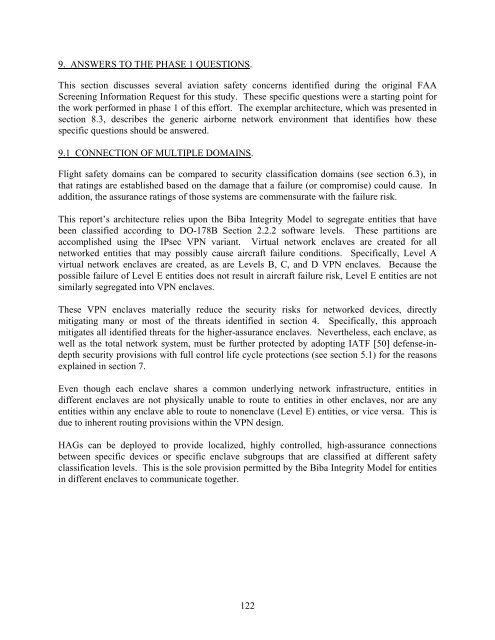Local Area Networks (LANs) in Aircraft - FTP Directory Listing - FAA
Local Area Networks (LANs) in Aircraft - FTP Directory Listing - FAA
Local Area Networks (LANs) in Aircraft - FTP Directory Listing - FAA
Create successful ePaper yourself
Turn your PDF publications into a flip-book with our unique Google optimized e-Paper software.
9. ANSWERS TO THE PHASE 1 QUESTIONS.<br />
This section discusses several aviation safety concerns identified dur<strong>in</strong>g the orig<strong>in</strong>al <strong>FAA</strong><br />
Screen<strong>in</strong>g Information Request for this study. These specific questions were a start<strong>in</strong>g po<strong>in</strong>t for<br />
the work performed <strong>in</strong> phase 1 of this effort. The exemplar architecture, which was presented <strong>in</strong><br />
section 8.3, describes the generic airborne network environment that identifies how these<br />
specific questions should be answered.<br />
9.1 CONNECTION OF MULTIPLE DOMAINS.<br />
Flight safety doma<strong>in</strong>s can be compared to security classification doma<strong>in</strong>s (see section 6.3), <strong>in</strong><br />
that rat<strong>in</strong>gs are established based on the damage that a failure (or compromise) could cause. In<br />
addition, the assurance rat<strong>in</strong>gs of those systems are commensurate with the failure risk.<br />
This report’s architecture relies upon the Biba Integrity Model to segregate entities that have<br />
been classified accord<strong>in</strong>g to DO-178B Section 2.2.2 software levels. These partitions are<br />
accomplished us<strong>in</strong>g the IPsec VPN variant. Virtual network enclaves are created for all<br />
networked entities that may possibly cause aircraft failure conditions. Specifically, Level A<br />
virtual network enclaves are created, as are Levels B, C, and D VPN enclaves. Because the<br />
possible failure of Level E entities does not result <strong>in</strong> aircraft failure risk, Level E entities are not<br />
similarly segregated <strong>in</strong>to VPN enclaves.<br />
These VPN enclaves materially reduce the security risks for networked devices, directly<br />
mitigat<strong>in</strong>g many or most of the threats identified <strong>in</strong> section 4. Specifically, this approach<br />
mitigates all identified threats for the higher-assurance enclaves. Nevertheless, each enclave, as<br />
well as the total network system, must be further protected by adopt<strong>in</strong>g IATF [50] defense-<strong>in</strong>depth<br />
security provisions with full control life cycle protections (see section 5.1) for the reasons<br />
expla<strong>in</strong>ed <strong>in</strong> section 7.<br />
Even though each enclave shares a common underly<strong>in</strong>g network <strong>in</strong>frastructure, entities <strong>in</strong><br />
different enclaves are not physically unable to route to entities <strong>in</strong> other enclaves, nor are any<br />
entities with<strong>in</strong> any enclave able to route to nonenclave (Level E) entities, or vice versa. This is<br />
due to <strong>in</strong>herent rout<strong>in</strong>g provisions with<strong>in</strong> the VPN design.<br />
HAGs can be deployed to provide localized, highly controlled, high-assurance connections<br />
between specific devices or specific enclave subgroups that are classified at different safety<br />
classification levels. This is the sole provision permitted by the Biba Integrity Model for entities<br />
<strong>in</strong> different enclaves to communicate together.<br />
122
















